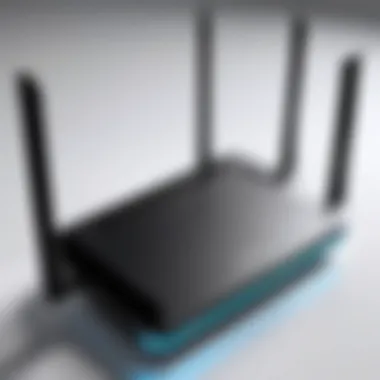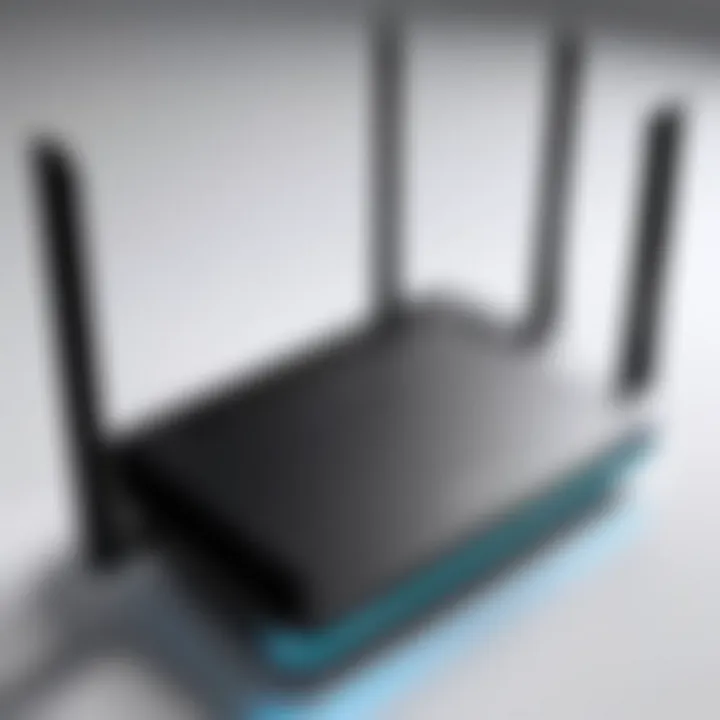Why is My WiFi So Slow? Common Issues & Fixes


Intro
In the digital age, a robust internet connection is essential. WiFi, a ubiquitous technology, powers countless devices, ranging from smartphones to smart home appliances. However, many users encounter frustratingly slow WiFi speeds. This issue can stem from various factors, some technical and others more related to environmental conditions or user behavior. Understanding these elements can be the first step toward restoring optimal performance.
This article aims to explore common reasons behind slow WiFi connections and offers practical solutions that individuals can implement. By empowering users with knowledge about their connectivity issues, they can take effective steps toward improvement.
Overview of the Technology
WiFi technology has evolved considerably over the past decades. The current standards, such as IEEE 802.11ac and 802.11ax (WiFi 6), provide faster speeds and better performance in crowded areas compared to their predecessors. Understanding these specifications is crucial for troubleshooting poor internet performance.
Key Specifications
- Frequency Bands: WiFi typically operates on 2.4 GHz and 5 GHz bands. The 2.4 GHz band covers a wider range but is more susceptible to interference. The 5 GHz band offers faster speeds but has a shorter range.
- Data Rate: The maximum theoretical data rate increases with newer standards. For example, WiFi 6 can achieve speeds up to 9.6 Gbps, far surpassing the capabilities of WiFi 5.
- Range: The effective range of WiFi networks can vary. Physical barriers like walls and floors can weaken signals significantly.
Unique Selling Points
The technology's unique features can improve user experience:
- Increased Capacity: Newer protocols support more simultaneous connections, beneficial in crowded environments.
- Efficiency: WiFi 6 introduces technology like OFDMA, which significantly improves data transmission efficiency.
- Security: Enhanced security protocols like WPA3 protect user data better than older standards.
Factors Contributing to Slow WiFi
Multiple factors might affect WiFi speed. Here are some of the most common:
- Router Placement: A router positioned too far from devices or obstructed by furniture can weaken the signal.
- Interference: Other electronic devices, such as microwaves or Bluetooth devices, can interfere with WiFi signals.
- Network Traffic: Multiple users or devices connected to the same network can slow speeds, especially with bandwidth-heavy applications.
User Actions to Improve WiFi Speed
Taking proactive steps can significantly enhance WiFi performance:
- Optimize Router Location: Place the router in a central location, away from walls and obstructions.
- Limit Connected Devices: Disconnect devices not in use to improve available bandwidth.
- Change Channels: Switching to less congested channels can reduce interference from nearby networks.
- Update Firmware: Regular firmware updates can resolve bugs that may slow down performance.
"Simple changes to your router and network setup can lead to noticeable improvements in your WiFi speed."
Understanding the technology behind WiFi, along with the common factors that contribute to slow speeds, equips users with the tools needed to optimize their internet connectivity. Future sections will delve into more detailed troubleshooting steps, helping readers take decisive action to rectify their slow WiFi concerns.
Preface to WiFi Speed Issues
In the digital age, the demand for rapid internet connectivity surges daily. Understanding WiFi speed issues becomes crucial for navigating this tech-centric environment. Today, almost every device connects to the internet, making speed a determining factor for productivity and entertainment. It’s essential to explore the nuances of WiFi connectivity. Various aspects contribute to slow connections, ranging from technical factors to environmental influences. By grasping these issues, users can seek solutions effectively.
Defining WiFi and its Importance
WiFi stands for Wireless Fidelity. It allows devices to connect to the internet without wires, using radio waves. This technology offers convenience and flexibility, enabling a wireless environment for communication, work, and leisure activities.
The significance of WiFi is profound. It allows for seamless streaming of videos, quick downloads, and reliable video calls. For businesses, a robust WiFi network translates into enhanced productivity. Residential users similarly benefit from uninterrupted service for entertainment or remote work needs. The increasing dependence on connected devices amplifies the need for fast and reliable internet.
The Impact of Slow WiFi
Slow WiFi can disrupt daily activities, often leading to frustrations. When connections lag, tasks take longer to complete. This inefficiency can affect personal enjoyment, such as streaming services buffering or games lagging.
In professional settings, slow speeds can hinder communication and collaboration. Besides decreased productivity, it can lead to missed deadlines and broken client interactions.
Furthermore, slow WiFi may lead users to question their service provider, impacting customer satisfaction. Therefore, addressing slow connections is not merely about speed; it is about fostering a more efficient and enjoyable online experience.
"In an environment dominated by the need for constant connectivity, understanding and addressing WiFi speed issues is no longer optional but essential."
Directories of connections, the amount of data being transmitted, and various factors directly impact user experience. By dissecting these elements, users can take actionable steps to refine their connectivity.
Common Reasons for Slow WiFi
Understanding the common reasons for slow WiFi is fundamental to improving internet performance. By identifying and analyzing these issues, users can take actionable steps to enhance their online experience. Slow WiFi may stem from several sources, including bandwidth limitations, network congestion, distance from the router, interference from devices, and outdated equipment. Addressing these factors can lead to noticeable improvements in connectivity.
Bandwidth Limitations
Bandwidth is the maximum rate of data transfer across a network. Each internet connection has a specific bandwidth allocated by the Internet Service Provider (ISP), which may not meet the needs of multiple users or devices. When too many devices attempt to use the same connection simultaneously, the available bandwidth is divided among them, resulting in slower speeds.
To check if bandwidth limitations are affecting your WiFi, consider running speed tests at different times of the day. If speeds are consistently lower than what your ISP advertises, reaching out to them for clarification may be necessary. Consider upgrading to a higher bandwidth plan if household usage requires it.


Network Congestion
Network congestion occurs when too many users or devices are connected to the same network, leading to slower internet speeds. This can happen in densely populated areas, apartment buildings, or during peak usage times. Even if you have a high-speed connection, local congestion can slow down your performance significantly.
To mitigate this, try scheduling bandwidth-heavy activities like downloads or streaming during off-peak hours. You can also limit the number of devices connected to your network simultaneously, ensuring that critical tasks receive priority access.
Distance from the Router
The physical distance from your router can greatly influence WiFi speed. The further you are from the router, the weaker the signal becomes. Walls, floors, and other obstructions can further degrade the signal strength. A weak signal can lead to an inconsistent internet connection, making tasks such as streaming or gaming frustrating.
For optimal speed, position the router in a central location in your home. Avoid placing it in cabinets or behind large furniture. If distance is an issue, you may need to invest in WiFi extenders or a mesh network to improve coverage in larger spaces.
Interference from Other Devices
Other electronic devices in your home can interfere with your WiFi signal. Common culprits include microwaves, cordless phones, and wireless security cameras, particularly those operating on the 2.4 GHz band. Such interference can lead to reduced speeds and lower connectivity times.
To reduce this interference, place your router away from potential sources of disruption. If possible, use the 5 GHz band, which is less susceptible to interference and typically offers faster speeds, albeit at a shorter range.
Outdated Equipment
Using outdated equipment can hinder your WiFi performance significantly. Older routers may not support current wireless standards like Wi-Fi 5 (802.11ac) or Wi-Fi 6 (802.11ax), which provide faster data transfer rates and better performance in crowded environments. If your router is more than five years old, it might be time for an upgrade.
Investing in modern routers enhances your connection and can provide benefits like improved security features and better range. This upgrade can address multiple slow WiFi issues, ensuring your network can handle the demands of today’s digital landscape.
Network Configuration Issues
Understanding the myriad network configuration issues is essential for diagnosing and resolving slow WiFi connections. These problems often stem from settings within the router or how it interacts with the internet service provider. Given the complexity of modern internet configurations, even minor adjustments can significantly enhance performance.
The configuration issues can influence how bandwidth is allocated, how devices communicate over the network, and even how internet packets are processed. Properly configured settings can greatly improve the overall user experience, while misconfigurations can lead to frustrating interruptions. As such, addressing these facets is critical to understanding and overcoming WiFi speed challenges.
Router Settings and Configuration
Router settings play a pivotal role in the performance of your WiFi network. When users first set up their routers, they often rely on default settings. These defaults are not always optimal for real-world usage. It is important to access the router’s administrative interface, typically through a web browser, to fine-tune these settings for better performance.
Common configurations that can be adjusted include:
- Channel Selection: Most routers operate on specific channels. Interference can occur when multiple routers use the same ones. Switch channels to one less crowded for improved speeds.
- Security Protocols: Ensuring the use of WPA3 over older protocols like WEP can enhance security without compromising speeds.
- Broadcast Frequency: Dual-band or tri-band routers allow users to choose between different frequencies (2.4 GHz and 5 GHz). The latter often provides faster speeds over shorter distances, making it a suitable option for streaming and gaming.
Quality of Service (QoS) Settings
Quality of Service (QoS) settings enable users to prioritize certain types of traffic. This can be crucial for households with multiple devices. For instance, video calls and streaming often require more bandwidth compared to simple web browsing. By adjusting QoS settings, users can assign higher priority to these time-sensitive applications, leading to smoother performance.
Key points about QoS include:
- Prioritization Structure: Users can create rules to ensure critical applications get the bandwidth they need.
- Traffic Management: This helps in avoiding slowdowns that occur during peak usage times.
- Balance Resources: Ensuring all devices can access the network without bottlenecks enables efficient multitasking.
DNS Configuration Problems
Domain Name System (DNS) configuration is another area that can affect WiFi speed. A DNS issue can result in slow response times when loading websites, leading to frustrating user experiences. Some common DNS problems include incorrect DNS settings or using a DNS provider that is slow.
To enhance performance, consider the following:
- Public DNS Servers: Switching from the default DNS of your Internet Service Provider (ISP) to faster alternatives like Google Public DNS or Cloudflare can yield quicker resolution times.
- Static vs Dynamic DNS: Configuring a static IP address along with a reliable DNS can avoid potential issues that arise from changing ISP assignments.
- Clear DNS Cache: Regular clearing of the DNS cache may prevent conflicts and delays when accessing websites.
Tip: Regularly check your DNS settings. Misconfigurations here can lead to significant slowdowns in network performance and accessibility issues.
By addressing these network configuration issues, users can unlock the full potential of their WiFi, ensuring a faster and more reliable internet experience.
External Factors Affecting WiFi Speed
External factors can significantly hinder the performance of your WiFi network. Understanding these elements aids users in diagnosing issues more effectively. This section focuses on key aspects like environmental obstacles, the number of connected devices, and service provider limitations that contribute to slow WiFi. Each of these factors has its implications and solutions, which are essential for maintaining optimal internet speed.
Environmental Obstacles
Environmental elements play a crucial role in WiFi performance. Physical barriers such as walls, floors, and even furniture can obstruct the signal. Materials like concrete, metal, and even water can absorb or reflect WiFi waves, diminishing strength. Additionally, external influences including neighboring networks and their signals can compete with yours. This competition can cause interference, particularly in crowded areas such as apartment buildings.
To mitigate these issues, consider the placement of your router. It should be in a central, elevated position within your home. Avoid enclosing the router in cabinets or behind large objects. Potential solutions may include using WiFi extenders or mesh networks to ensure that your coverage is consistent throughout your space.
Increasing Number of Connected Devices


The number of devices connected to a single network directly impacts WiFi speed. Every online device consumes bandwidth, whether it's smartphones, tablets, Smart TVs, or IoT devices. As more devices join the network, speed may slow for each one. This is particularly problematic during peak usage times when many devices are active at once.
To address this issue, users should regularly assess how many devices are connected. Disconnect any devices that do not need an active connection. Alternatively, upgrading your internet plan or router with higher capacity can greatly enhance performance. Additionally, prioritizing traffic through Quality of Service (QoS) settings on your router helps ensure that critical devices receive the needed bandwidth first.
ISP Throttling
Internet Service Provider (ISP) throttling is another significant factor affecting WiFi speed. ISPs may intentionally slow down your internet connection based on your usage patterns. This often occurs when users exceed data caps or during times of network congestion. Understanding if your ISP engages in throttling can provide clarity on persistent slow speeds.
To verify if throttling is the issue, conduct regular speed tests throughout the day. If there are significant discrepancies during peak hours, you might indeed be a victim of this practice. In such cases, contacting your ISP to discuss options is advisable. Sometimes, changing your plan or provider may be necessary to achieve consistent speeds.
"Identifying the external factors that affect WiFi speed is vital for optimizing your internet experience. Factors like environmental obstacles, device load, and ISP practices can be the key to resolving your connectivity issues."
In summary, external factors have a profound influence on WiFi performance. By understanding and addressing these issues, users can work towards achieving a faster, more stable internet connection.
Identifying WiFi Speed Issues
Identifying the issues that cause slow WiFi is crucial for improving your online experience. Understanding these problems allows you to take effective measures to enhance speed and reliability. This section emphasizes the significance of recognizing and diagnosing network-related troubles. By pinpointing the source of slow WiFi, users can apply tailored solutions rather than guessing or making random adjustments to their setup.
Testing Your Internet Speed
Testing your internet speed is a fundamental first step in identifying WiFi issues. It provides immediate feedback about the actual performance of your connection. You can utilize tools like Ookla's Speedtest or Fast.com to measure download and upload speeds, as well as ping latency. Each of these metrics offers insight into how well your WiFi is performing.
- Download Speed: This indicates how quickly data is transferred to your device. A slow download speed can signal either inadequate bandwidth or other interference.
- Upload Speed: This measures how fast data is sent from your device to the internet. Low upload speeds can affect activities like video conferencing or uploading files.
- Ping Latency: This value reflects the time it takes for a signal to travel from your device to the server and back. Higher latency can cause delays, especially in online gaming or video streaming.
Running tests at different times of the day and in various locations around your home can help establish patterns. Consistently slow performance may suggest a need for further investigation into your home network setup or possibly contacting your Internet Service Provider (ISP).
Detecting Network Congestion
Detecting network congestion is key to diagnosing slow WiFi issues. This phenomenon occurs when too many users or devices use the same bandwidth, leading to slower speeds for everyone. You can take proactive steps to monitor your network activity.
- Check Connected Devices: Access your router's interface to view all devices connected to your network. If there are unknown devices, it might be a sign that someone is using your connection without permission.
- Time of Day Impact: Observe if speeds drop during peak usage hours, such as evenings when many people are streaming content or gaming. If congestion aligns with these periods, consider scheduling bandwidth-heavy tasks for quieter times.
- Use Network Management Tools: Utilizing software that analyzes network traffic can help detect potential bottlenecks. Programs like GlassWire or Paessler PRTG Network Monitor provide insights into usage patterns and device activity.
Being aware of network congestion leads to informed decisions. By limiting the number of active devices or upgrading your hardware, it's possible to enhance your connection's performance and alleviate slow WiFi issues.
Troubleshooting Slow WiFi
Troubleshooting slow WiFi is a critical step for anyone facing connectivity problems. It allows users to pinpoint and resolve issues effectively. Understanding and implementing troubleshooting strategies can lead to improved internet performance. This section covers various methods to address slow WiFi, which can benefit anyone from casual users to tech enthusiasts.
Rebooting Your Router
One of the simplest yet often overlooked solutions to slow WiFi is rebooting your router. It may sound basic, but performing a restart can refresh your network connection and resolve many issues. When a router runs continuously for long periods, it can become sluggish due to memory overload or conflicting processes. A restart clears temporary data, eliminating these variables. Most importantly, it helps in reconnecting to the Internet Service Provider, often solving problems stemming from a lost connection.
To reboot your router, follow these steps:
- Locate your router's power supply.
- Unplug the power cord from the outlet or the router itself.
- Wait for about 30 seconds.
- Plug the router back in and let it fully restart, which usually takes a few minutes.
This method is quick and does not require any specialized knowledge. If after rebooting your WiFi speed is still slow, it may be time to explore other solutions.
Changing WiFi Channels
Another essential troubleshooting method involves changing your WiFi channels. Routers typically operate on specific channels within the 2.4 GHz and 5 GHz bands. If multiple networks operate on the same channel, it can cause interference, resulting in slower speeds.
To determine the best channel:
- Use tools like WiFi Analyzer (for Android) or inSSIDer (for Windows) to scan your network.
- Check which channels are most crowded.
Once you identify a less congested channel, you can change your router settings:
- Access the router's web interface, usually at 192.168.1.1 or 192.168.0.1 in your browser.
- Log in with your admin credentials.
- Navigate to the wireless settings or channel options.
- Select a new channel and save the changes.
This can dramatically improve connectivity, particularly in densely populated areas with numerous networks. Optimizing the channel will ensure you have less interference and better speed.
Updating Router Firmware
Keeping your router firmware up to date is another crucial step in troubleshooting slow WiFi issues. Manufacturers regularly release firmware updates to fix bugs, enhance security features, and improve overall performance. An outdated router may not be able to handle current speeds or new devices, which can result in subpar performance.
To update your firmware:
- Check your router manufacturer's website for the latest firmware version.
- Access the router's web interface.
- Locate the firmware section. It may be under "Administration" or "Settings."
- If there's an update available, download the firmware file and upload it via the interface.


Not all routers have an automatic update feature, so it's wise to perform this action periodically. This step not only resolves existing issues but can also prevent potential problems in the future.
Regular updates yield a stable and secure network, optimizing your WiFi experience.
By following these troubleshooting steps, users can actively address and resolve their slow WiFi issues.
Advanced Solutions for Persistent Issues
In the realm of WiFi connectivity, slow speeds can be frustrating. While basic troubleshooting often helps, there are times when more advanced solutions are necessary. This section explores the importance of recognizing persistent issues and how addressing them can significantly enhance your internet experience.
In many scenarios, consistent low speeds can be symptomatic of deeper problems, often linked with outdated hardware or insufficiently configured networks. Understanding and implementing advanced solutions not only optimizes performance but can also extend the lifespan of your network infrastructure.
Taking the time to assess and upgrade your equipment is vital. Technology evolves rapidly, and older routers may not leverage the full potential of newer high-speed internet plans. The benefits of enhanced hardware include broader coverage, improved connections in obstructions, and a more robust network that can handle multiple devices without a dip in performance. The following subsections delve into two key advanced solutions that can address persistent slow WiFi issues.
Upgrading Router Hardware
Upgrading router hardware can lead to a marked improvement in WiFi performance. Older routers may not support the latest standards, like Wi-Fi 6, which offers faster speeds and better performance in congested environments. Newer models often come with improved antennas and beamforming technology, which directs signals more effectively towards connected devices.
When considering an upgrade, users should assess their current internet speed and the demands of their household. For instance, if multiple users are streaming high-definition video or engaging in online gaming simultaneously, a higher-end router will manage traffic far better than older models. Moreover, dual-band or tri-band routers can alleviate congestion by distributing devices across different frequencies.
Some considerations when upgrading include:
- Compatibility with ISP: Ensure the router is compatible with your Internet Service Provider.
- Coverage Area: Choose a router that meets the size of your space. Larger areas may require more robust systems.
- Budget: Balance features and pricing according to your immediate needs.
In sum, upgrading hardware is a strategic move that addresses not only performance but also future-proofs your network against emerging technologies.
Implementing WiFi Extenders or Mesh Networks
For those noticing persistent slow speeds in specific areas of their home, implementing WiFi extenders or mesh networks can drastically improve connectivity. These solutions help in overcoming distances and obstructions that limit WiFi coverage.
WiFi extenders operate by picking up signals from the main router and enlarging the area covered. However, users should note that extenders can sometimes halve bandwidth due to increased distance. Therefore, they may be more effective for small to medium-sized areas.
On the other hand, mesh networks consist of multiple interconnected nodes that communicate with each other. They create a blanket of WiFi coverage, eliminating dead zones and ensuring a consistent connection throughout your space. Mesh systems can be especially advantageous in larger homes or spaces with thick walls that obstruct signals.
Key benefits of using mesh networks:
- Seamless roaming: Devices switch seamlessly between nodes without interrupting service.
- Scalability: Additional nodes can be added easily for expanding coverage.
- Centralized management: Many systems allow for easy monitoring and management through mobile apps.
Regular Maintenance and Monitoring
Regular maintenance and monitoring of your WiFi connection is crucial for ensuring optimal performance. Just like any technical system, WiFi networks require periodic checks to operate efficiently. Over time, performance may degrade due to various factors, ranging from equipment wear to network configuration changes. By incorporating a routine maintenance plan, you can preemptively address potential issues before they significantly affect your connectivity.
One of the primary benefits of regular maintenance is that it helps identify underlying problems swiftly. This process includes tasks like monitoring connected devices, running speed tests, and checking for firmware updates. If problems arise, you will be better equipped to troubleshoot them effectively. Regular checks also help maintain the efficiency of the network, providing a cleaner and faster experience for all users.
Periodic Speed Tests
Conducting periodic speed tests is an essential aspect of monitoring your WiFi network. These tests provide a snapshot of your current internet speed, allowing users to determine if they are receiving the bandwidth they are paying for. Several tools and websites, such as Ookla’s Speedtest or Fast.com, can help you measure upload and download speeds.
It is advisable to perform these tests at different times of the day. Internet congestion can vary depending on the time and the number of active users on your network, making it critical to gather data over various periods. If the speeds consistently fall below expected levels, it may indicate an issue that needs further investigation, such as router placement, interference, or ISP-related problems.
Monitoring Connected Devices
Keeping an eye on the devices connected to your WiFi network is another key component of effective maintenance. An increasing number of devices can lead to slower speeds and network congestion. Understanding which devices are using bandwidth can help you manage resources more effectively.
Many routers offer management tools that allow you to view connected devices in real-time. These tools can help you identify unauthorized devices or unnecessary connections that may be draining your bandwidth. For instance, if you notice multiple smart devices connected when they shouldn’t be, it might be time to disconnect or limit their access.
Additionally, monitoring helps inform decisions about upgrades or adjustments needed to your network. If certain devices use a lot of bandwidth, you may want to prioritize their connectivity or upgrade your router to ensure better performance overall.
Regular maintenance, including speed tests and device monitoring, can significantly improve your WiFi experience, ensuring you make the most of your internet connection.
The End
Understanding the complexities surrounding WiFi speed is essential for anyone who relies on internet connectivity. This article has detailed various aspects that contribute to slow WiFi, ranging from technical issues like outdated equipment to external factors like network congestion. By identifying these factors, readers can take effective measures to improve their connection.
Summarizing Key Points
- Technical Issues: Outdated hardware and misconfigured settings can drastically influence internet performance.
- Network Congestion: A high number of connected devices can lead to slowdowns, particularly during peak hours.
- Environmental Factors: Physical barriers and interference from other electronic devices can hinder signal strength.
- Regular Maintenance: Periodic speed tests and firmware updates help maintain optimal performance.
- Actionable Solutions: Users can proactively enhance their WiFi experience through simple adjustments like rebooting their routers or changing WiFi channels.
These insights emphasize that slow WiFi is often a result of multiple interacting issues. Addressing each potential problem methodically can lead to a better and more reliable internet experience.
Encouragement for Proactive Solutions
Navigating WiFi challenges should not feel overwhelming. Instead, it can be an empowering process. Taking consistent and proactive steps is key. Regular checks on your network performance, being aware of the number of devices connected, and timely updates can go a long way. Investing in quality hardware like a reliable router or a mesh network setup often pays dividends in speed and reliability.
Staying informed about WiFi technologies and solutions is critical in today’s digital age. Engage with communities and resources such as Reddit or specialized forums to share experiences and seek solutions. This collective knowledge can facilitate overcoming various connectivity hurdles.







